Laghu Abhyangas
In Ayurveda, “Laghu Abhyanga” refers to a light or gentle massage using therapeutic oils. Abhyanga is a traditional Ayurvedic massage technique that involves the application of medicated or herbal oils to the body, and “laghu” translates to “light” or “gentle.
1. Sthanika Abhyanga
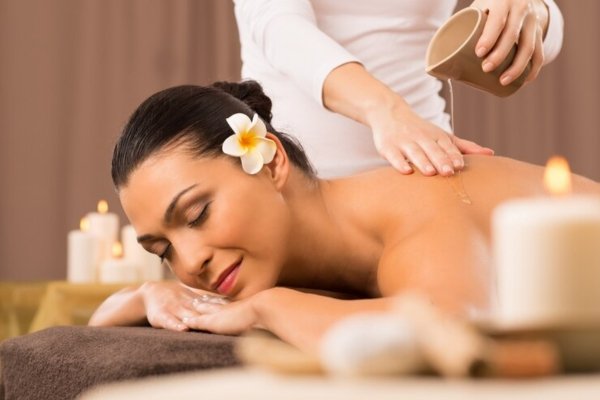
Sthanika Abhyanga, a traditional Ayurvedic therapy, is a localized oil massage technique that focuses on specific areas of the body, such as the back, shoulders, neck, and arms. Derived from the Sanskrit words “Sthanika,” meaning localized, and “Abhyanga,” meaning oil massage, this therapeutic practice aims to provide targeted relaxation, pain relief, and rejuvenation to the chosen area.
During a Sthanika Abhyanga session, warm herbal oils or medicated oils are applied to the specified body part and massaged using gentle yet firm strokes. The therapist employs rhythmic movements and circular motions to stimulate the muscles, tissues, and marma points (vital energy points) in the localized area. The oils used in Sthanika Abhyanga are selected based on the individual’s constitution (prakriti), specific health concerns, and therapeutic goals.
Benefits :
- Muscle Relaxation: Helps relax tense muscles, reducing stiffness and discomfort.
- Stress Relief: Promotes relaxation of the mind and body, reducing stress and anxiety.
- Improved Circulation: Stimulates blood flow to the targeted areas, enhancing circulation and promoting healing.
- Joint Mobility: Helps improve flexibility and mobility in the joints, reducing stiffness and promoting ease of movement.
- Enhanced Well-being: Provides a sense of rejuvenation and well-being, leaving you feeling refreshed and revitalized.
2. Sthanika Udvarthana

Sthanika Udvarthana is an Ayurvedic therapy that involves the application of herbal powders or pastes to specific areas of the body, followed by massage using upward strokes. Derived from the Sanskrit words “Sthanika,” meaning localized, and “Udvarthana,” meaning upward strokes, this therapeutic practice aims to provide targeted exfoliation, stimulation, and rejuvenation to the chosen area.
During a Sthanika Udvarthana session, herbal powders or pastes are carefully chosen based on the individual’s constitution (prakriti), specific health concerns, and therapeutic goals. The herbal mixture is then applied to the localized area and massaged using upward strokes, which helps to stimulate the skin, open the pores, and promote the removal of toxins and impurities.
Benefits:
- Exfoliation: Helps remove dead skin cells, toxins, and impurities from the skin’s surface, promoting smoother and softer skin.
- Stimulation of Circulation: Improves blood flow to the targeted areas, enhancing circulation and promoting detoxification.
- Toning and Tightening: Helps tighten and tone the skin, reducing the appearance of cellulite and promoting a firmer complexion.
- Muscle Relaxation: Relieves tension and stiffness in the muscles, promoting relaxation and reducing muscle pain.
- Stress Relief: Promotes relaxation of the mind and body, reducing stress, anxiety, and fatigue.
- Lymphatic Drainage: Stimulates the lymphatic system, helping to remove toxins and excess fluid from the body, which can reduce swelling and improve overall health.
3. Sthanika Pichu
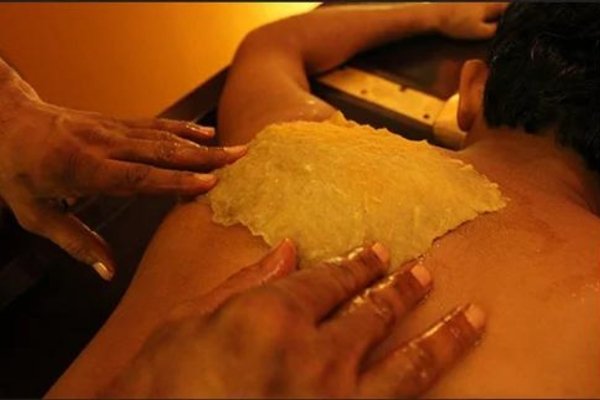
Sthanika Pichu is an Ayurvedic therapy that involves applying a cotton pad or cloth soaked in warm herbal oil to a specific area of the body, such as the head, neck, spine, or joints. This therapeutic technique is derived from the Sanskrit words “Sthanika,” meaning localized, and “Pichu,” meaning poultice or bandage.
During a Sthanika Pichu session, the cotton pad or cloth is soaked in warm herbal oil, often infused with Ayurvedic herbs or medicated oils chosen based on the individual’s constitution (prakriti) and specific health concerns. The saturated pad is then placed over the targeted area and left in position for a specified duration, allowing the herbal oils to penetrate deeply into the skin and tissues.
Benefits:
- Localized Moisturization: The warm herbal oil deeply moisturizes and nourishes the skin in the targeted area, leaving it soft and supple.
- Pain Relief: Helps alleviate localized pain and discomfort, such as muscle soreness, joint stiffness, or tension headaches.
- Relaxation: Promotes relaxation of the muscles and nerves in the targeted area, reducing stress and promoting a sense of calm.
- Improves Circulation: Enhances blood flow to the area, which can help speed up the healing process and reduce inflammation.
- Supports Healing: Assists in the healing of minor injuries, strains, or sprains by providing warmth, moisture, and nourishment to the affected tissues
4. Shirobhyanga
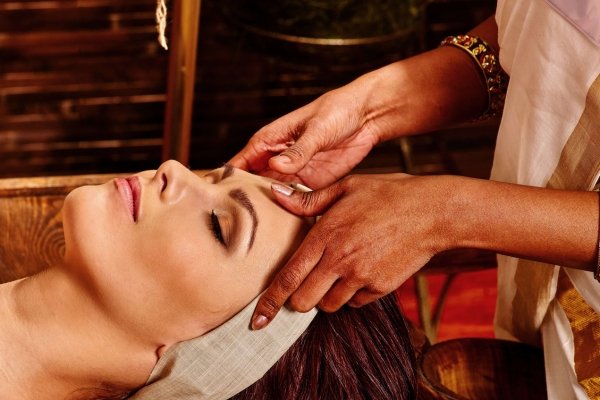
Shirobhyanga, derived from the Sanskrit words “shiro” meaning head and “abhyanga” meaning oil massage, is a traditional Ayurvedic practice of massaging the head, scalp, and neck with warm herbal oils or medicated oils. This ancient healing therapy has been practiced for centuries in India as part of Ayurvedic wellness rituals and therapeutic treatments.
Shirobhyanga is based on the principles of Ayurveda, which views the head as the primary seat of the senses and the vital energy centers known as marma points. By massaging the head and scalp, Shirobhyanga aims to balance the doshas (vata, pitta, and kapha), promote relaxation, and stimulate the flow of prana (life force energy) throughout the body.
Benefits :
- Stress Alleviation and Relaxation: Induces deep relaxation, potentially alleviating stress, anxiety, and mental fatigue.
- Hair and Scalp Health Enhancement:May stimulate the scalp, promoting improved hair follicle nourishment and fostering healthier hair.
- Improved Blood Circulation:Aids in enhancing blood circulation in the head region, benefiting scalp and brain health.
- Mental Clarity and Focus:Assists in fostering mental clarity, potentially aiding in concentration and mental focus.
- Energetic Balance and Holistic Wellness:Harmonizes the body’s subtle energies, potentially contributing to an overall sense of well-being and balance.
5. Padabhyanga
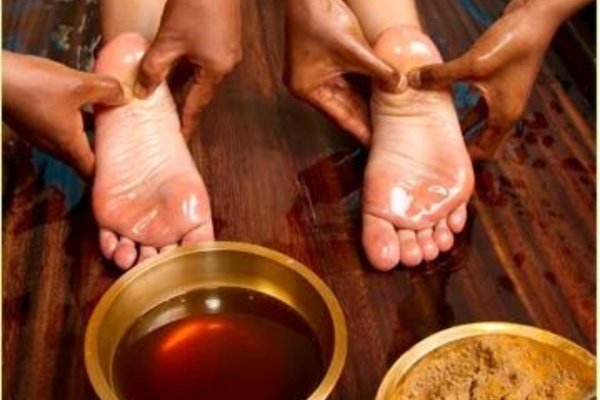
Padabhyanga, originating from the Sanskrit words “pada” meaning foot and “abhyanga” meaning oil massage, is a traditional Ayurvedic practice of massaging the feet with warm herbal oils or medicated ghee. Considered as one of the most ancient healing techniques, Padabhyanga is deeply rooted in Ayurvedic philosophy and holistic wellness principles.
In Padabhyanga, the therapist applies gentle pressure and rhythmic strokes to the feet, focusing on specific marma points (vital energy points) and reflex zones that correspond to various organs and systems of the body. This therapeutic massage not only relaxes the feet but also stimulates the entire body’s energy flow, promoting balance and harmony.
Benefits :
- Stress Relief and Relaxation: Induces deep relaxation, potentially alleviating stress, anxiety, and promoting overall mental calmness.
- Enhanced Sleep Quality: By reducing stress and inducing relaxation, Padabhyanga may contribute to better sleep patterns and improved sleep quality.
- Improved Circulation: Stimulates blood circulation in the feet, potentially benefiting overall circulation and vitality.
- Foot Health Maintenance: May aid in addressing foot discomfort, stiffness, or tension, contributing to better foot health.
- Energetic Balance: Balances the subtle energy pathways in the body, potentially harmonizing the flow of energy for holistic well-being.
- Relief from Aches and Fatigue: Offers potential relief from tired feet, muscle aches, or fatigue, revitalizing the lower extremities.
6. Sthanika PPS
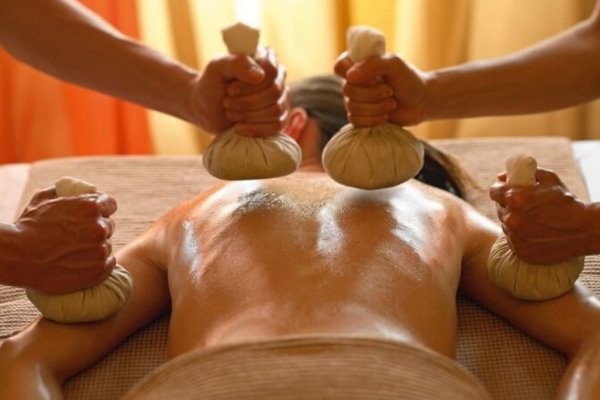
Sthanika PPS refers to “Sthanika Pinda Sweda,” an Ayurvedic therapy that involves the application of boluses filled with medicinal herbs and oils to specific areas of the body. This therapy aims to provide localized heat, massage, and herbal benefits to the targeted area, promoting relaxation, pain relief, and rejuvenation. Sthanika PPS is often used to address musculoskeletal issues such as muscle stiffness, joint pain, inflammation, and neurological disorders. It is a deeply therapeutic treatment that helps improve circulation, reduce tension, and support overall well-being.
Benefits :
- Pain Relief: Helps alleviate localized pain and discomfort, such as muscle soreness, joint stiffness, or arthritis.
- Muscle Relaxation: Promotes relaxation of the muscles in the targeted area, reducing tension and stiffness.
- Improves Circulation: Enhances blood flow to the area, which can aid in the healing process and reduce inflammation.
- Detoxification: Assists in the removal of toxins and impurities from the tissues, promoting overall health and well-being.
- Nourishment: Provides nourishment to the skin and underlying tissues, leaving the area feeling moisturized and rejuvenated.
7. Sthanika SSPS
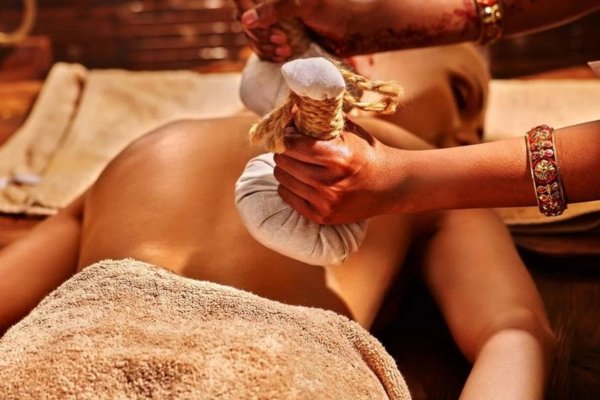
Sthanika SSPS refers to “Sthanika Shashtika Shali Pinda Sweda,” an Ayurvedic therapy that involves the application of boluses filled with a mixture of cooked rice and medicinal herbs to specific areas of the body. This therapy aims to provide localized heat and nourishment to the targeted area, promoting relaxation, pain relief, and rejuvenation. Sthanika SSPS is often used to address musculoskeletal issues such as muscle stiffness, joint pain, inflammation, and neurological disorders. It is a deeply therapeutic treatment that helps improve circulation, reduce tension, and support overall well-being.
Benefits:
- Pain Relief: Helps alleviate localized pain, including muscle soreness, joint stiffness, and arthritis discomfort.
- Muscle Relaxation: Promotes relaxation of tense muscles, reducing stiffness and improving flexibility.
- Improves Circulation: Enhances blood flow to the targeted area, aiding in the healing process and reducing inflammation.
- Nourishment: Provides nourishment to the skin and tissues, leaving the area feeling moisturized and rejuvenated.Stress Reduction: Promotes relaxation and reduces stress levels, contributing to overall well-being and mental calmness.
8. Sthanika Dhara

Sthanika Dhara is an Ayurvedic therapy where a continuous stream of warm herbal oil or medicated liquid is poured over a specific area of the body, typically the forehead or a particular body part. This therapeutic technique aims to induce deep relaxation, balance the doshas (energetic forces), and promote healing in the targeted area. Sthanika Dhara is often used to alleviate stress, anxiety, headaches, insomnia, and various neurological disorders. It is a deeply soothing and rejuvenating treatment that helps harmonize the mind, body, and spirit.
Benefits:
- Relaxation: Promotes relaxation of the muscles and nerves in the targeted area, reducing stress and tension.
- Pain Relief: Helps alleviate localized pain and discomfort, such as muscle soreness, joint stiffness, or tension headaches.
- Nourishment: Provides deep nourishment to the skin and tissues, leaving the area feeling moisturized and rejuvenated.
- Improves Circulation: Enhances blood flow to the area, aiding in the healing process and reducing inflammation.
- Detoxification: Assists in the removal of toxins and impurities from the tissues, promoting overall health and well-being.
9. Sthanika CPS

Sthanika CPS, or Sthanika Choorna Pinda Sweda, is an Ayurvedic therapy that involves the application of boluses filled with herbal powders to specific areas of the body. This therapeutic practice is derived from the Sanskrit words “Sthanika,” meaning localized, “Choorna,” meaning herbal powder, “Pinda,” meaning bolus, and “Sweda,” meaning sweat-inducing therapy. Sthanika CPS aims to provide targeted heat, massage, and herbal benefits to the chosen area, promoting relaxation, pain relief, and rejuvenation.
During a Sthanika CPS session, herbal powders are carefully selected based on the individual’s constitution (prakriti), specific health concerns, and therapeutic goals. The herbal mixture is then wrapped in a cloth or poultice and heated before being applied to the localized area. The therapist uses gentle pressure and circular motions to massage the boluses onto the skin, allowing the herbal powders to penetrate deeply into the tissues.
Benefits :
- Localized Pain Relief: Alleviates discomfort and pain in targeted areas such as the back, shoulders, or joints.
- Muscle Relaxation: Helps to relax tense muscles, reducing stiffness and promoting a sense of relaxation.
- Improved Circulation: Enhances blood flow to the localized area, aiding in the delivery of nutrients and oxygen to tissues.
- Detoxification: Assists in removing toxins and impurities from the tissues, supporting the body’s natural detoxification processes.
- Stress Reduction: Promotes relaxation and mental calmness, reducing stress and tension in the body.
10. CPS for legs
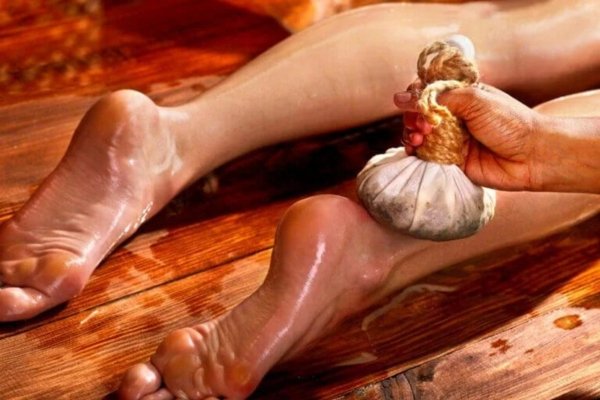
CPS for legs, also known as Choorna Pinda Sweda for legs, is an Ayurvedic therapy that involves the application of boluses filled with herbal powders to the legs. This therapeutic practice aims to provide targeted heat, massage, and herbal benefits to the lower extremities, promoting relaxation, pain relief, and rejuvenation.
During a CPS for legs session, herbal powders are carefully selected based on the individual’s constitution (prakriti), specific health concerns, and therapeutic goals. The herbal mixture is then wrapped in a cloth or poultice and heated before being applied to the legs. The therapist uses gentle pressure and circular motions to massage the boluses onto the skin, allowing the herbal powders to penetrate deeply into the tissues.
Benefits :
- Pain Relief: Alleviates muscle tension, stiffness, and discomfort in the legs.
- Muscle Relaxation: Helps to relax tense muscles, promoting a sense of ease and well-being.
- Improved Circulation: Enhances blood flow to the legs, aiding in the delivery of nutrients and oxygen to tissues.
- Detoxification: Assists in removing toxins and impurities from the legs, supporting overall detoxification.
- Enhanced Flexibility: Improves flexibility and range of motion in the legs, promoting better mobility.
- Stress Reduction: Reduces stress and tension, promoting relaxation and mental calmness.
